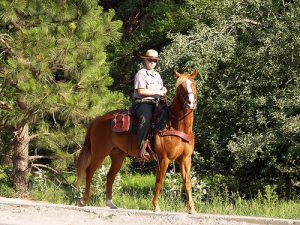America’s Magnificent 7 National Parks

The American National Park Service was created by congress in 1916, with the aim of preserving the historical artefacts and natural wonders within these areas, that they could be enjoyed by future generations. Currently more than 338,000 square kilometres of American soil and water are considered national parks, around half of which are in private hands.

– Visits from schools in urban areas; youth programs such as Yellowstone’s Young Rangers
– Many parks see millions of visitors every year for a variety of purposes
– Just some examples include hiking, mountain-biking, rafting, fishing, skiing, sailing, and hunting
– National parks are home to many endangered species of animals and plants
– Not just of historic sites, but also old traditions and ways of life
– Many communities wouldn’t be able to survive without grants from the NPS or tourist dollars
Let’s take a look at just one of these, tourism. From a visitor’s perspective, which are the most popular parks to visit, and why?

The Great Smokey Mountains run from Tennessee to South Carolina. The name originates from the low-lying fog that often shrouds the peaks from view. It’s the most visited park in America, which probably has a lot to do with its size, but also its versatility – there’s an abundance of things to do here, from climbing, rafting and skiing, to gentle nature walks and picnics.
Very few things on this earth are likely to induce such a feeling as looking over the edge of the Grand Canyon. It’s a jaw-dropping sight, over a mile deep and eighteen miles wide. You can raft the river that runs through it, hike or horse-ride down there; even take a helicopter over the rim. And Las Vegas is only a short distance away.
I’ve written about Yellowstone many times before. It’s got so many things going for it, Old Faithful, the miles of open trails, dozens of waterfalls, but the biggest draw has got to be the wildlife. Bears, wolves, elk, moose – paradise for naturalists.
Right at the tip of Florida, pretty much America’s most southern point, lies a sub-tropical wilderness, a unique and fragile wetlands ecosystem and one of the most fascinating places in the USA national parks system. Here, panthers, sharks, alligators and crocodiles patrol mangrove swamps, so swimming is inadvisable.
From the far south-east of America to the far north-west, Glacier National Park in Montana provides a home to grizzly bear, lynx and cougar among other fauna. Sadly, the mighty glaciers that give the park its name, which were formed during the last ice age, are now rapidly disappearing, and the last of them is expected to be gone by around 2020.
The desert landscape of Utah is a thrilling destination for hikers, as they squeeze through narrow canyon walls, or stare up at imposing sandstone peaks. For mountain-bikers, there’s nowhere else they’d rather be. The slickrock trails here are among the most challenging and exciting in the world, and attract thousands of bikers every year.
The island chain of Hawaii is a volcanic archipelago. Two of the world’s most active volcanoes, Kilauea and Mauna Loa, smoke away on the Big Island. It’s safe to visit but be wary – in 197- a party of warriors were killed in an eruption – their footprints are still visible in the solidified lava. And if you can’t stand the heat – you can just head down to some of the most idyllic beaches imaginable.
